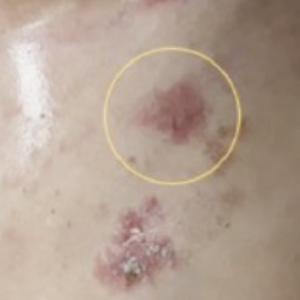A case report of Hailey-Hailey disease treated with fractional carbon dioxide laser

HTML: 9
All claims expressed in this article are solely those of the authors and do not necessarily represent those of their affiliated organizations, or those of the publisher, the editors and the reviewers. Any product that may be evaluated in this article or claim that may be made by its manufacturer is not guaranteed or endorsed by the publisher.
Hailey-Hailey disease (HHD), or familial benign pemphigus, is a rare genetic condition characterized by recurrent blisters and erosions with a predilection for intertriginous areas. There is no specific treatment for HHD. Topical and systemic treatments tend to provide temporary remission. Alternative treatment (surgical interventions such as dermabrasion, excision, and laser) has been shown to prolong remission. Considering the risk of complications associated with surgical modalities, laser is often preferred as an alternative for patients failing to respond to first-line therapies. We report a case of recalcitrant HHD successfully treated with a fractional ablative CO2 laser procedure (wavelength of 10600 nm, power of 7-10 W, 2-3 passes) on a 35-year-old female. The patient has a 7-year history of therapy-resistant HHD. A 2-month followup showed substantially resolved lesions, with mild erythema and post-inflammatory hyperpigmentation in treated areas.
Hailey H, Hailey H. Familial benign chronic pemphigus. Arch Dermatol Syphilol 1939;39:679-685. DOI: https://doi.org/10.1001/archderm.1939.01480220064005
Chiaravalloti A, Payette M. Hailey-Hailey disease and review of management. J Drugs Dermatol 2014;13:1254-1257.
Patel VM, Rubins S, Schwartz RA et al. Hailey-Hailey disease: a diagnostic challenge. Cutis 2019;103:157-159.
Farahnik B, Blattner CM, Mortazie MB et al. Interventional treatments for Hailey Hailey disease. J Am Acad Dermatol. 2017;76:551-558. DOI: https://doi.org/10.1016/j.jaad.2016.08.039
Ben Lagha I, Ashack K, Khachemoune A. Hailey-Hailey Disease: An Update Review with a Focus on Treatment Data. Am J Clin Dermatol 2020;21:49-68. DOI: https://doi.org/10.1007/s40257-019-00477-z
Pretel-Irazabal M, Lera-Imbuluzqueta JM, Espana-Alonso A. Carbon dioxide laser treatment in Hailey-Hailey disease: a series of 8 patients. Actas Dermosifiliogr 2013;104:325-333. DOI: https://doi.org/10.1016/j.adengl.2013.03.004
Kruppa A, Korge B, Lasch J et al. Successful treatment of Hailey-Hailey disease with a scanned carbon dioxide laser. Acta Derm Venereol 2000;80:53-54 DOI: https://doi.org/10.1080/000155500750012568
Falto-Aizpurua LA, Griffith RD, Yazdani Abyaneh MA et al. Laser therapy for the treatment of Hailey-Hailey disease: a systematic review with focus on carbon dioxide laser resurfacing. J Eur Acad Dermatol Venereol 2015;29:1045-52 DOI: https://doi.org/10.1111/jdv.12875
Campuzano-García AE, Torres-Alvarez B, Hernández-Blanco D et al. Hailey-Hailey disease improved by fractional CO2 laser. J Cosmet Laser Ther 2015;17:213-5. DOI: https://doi.org/10.3109/14764172.2015.1007063
Grönemeyer LL, Thoms KM, Bertsch HP et al. Reflectance confocal microscopy and Hailey-Hailey disease: assessment of response to treatment after CO2 laser ablation. J Dtsch Dermatol Ges 2014;12:1135-7. DOI: https://doi.org/10.1111/ddg.12503
Vilela VN, Carvalho CGS, Carvalho GSM et al. Treatment of the Hailey-Hailey disease with fractional CO2 laser: a three-case series. Surg Cosmet Dermatol 2017;9:91-3. DOI: https://doi.org/10.5935/scd1984-8773.201791895
Ortiz AE, Zachary CB. Laser therapy for Hailey-Hailey disease: review of the literature and a case report. Dermatol Reports 2011;3:e28. DOI: https://doi.org/10.4081/dr.2011.e28
Hochwalt PC, Christensen KN, Cantwell SR et al. Carbon dioxide laser treatment for Hailey-Hailey disease: a retrospective chart review with patient-reported outcomes. Int J Dermatol 2015;54:1309-14. DOI: https://doi.org/10.1111/ijd.12991
Touma DJ, Krauss M, Feingold DS et al. Benign familial pemphigus (Hailey-Hailey disease). Treatment with the pulsed carbon dioxide laser. Dermatol Surg 1998;24:1411-4. DOI: https://doi.org/10.1111/j.1524-4725.1998.tb00025.x
Christian MM, Moy RL. Treatment of Hailey-Hailey disease (or benign familial pemphigus) using short pulsed and short dwell time carbon dioxide lasers. Dermatol Surg 1999;25:661-3. DOI: https://doi.org/10.1046/j.1524-4725.1999.99025.x
Copyright (c) 2023 the Author(s)

This work is licensed under a Creative Commons Attribution-NonCommercial 4.0 International License.
PAGEPress has chosen to apply the Creative Commons Attribution NonCommercial 4.0 International License (CC BY-NC 4.0) to all manuscripts to be published.





 https://doi.org/10.4081/dr.2023.9658
https://doi.org/10.4081/dr.2023.9658



